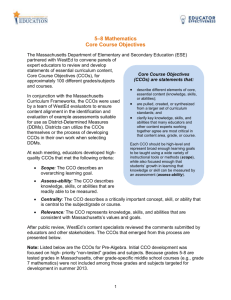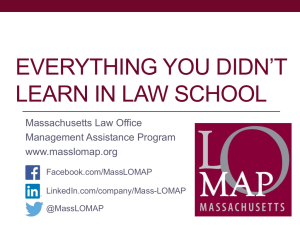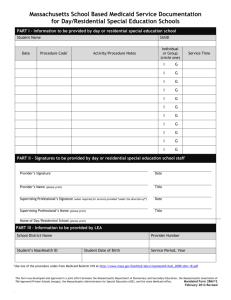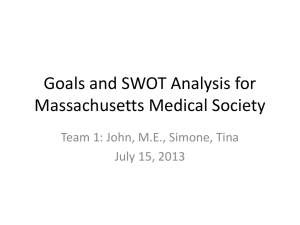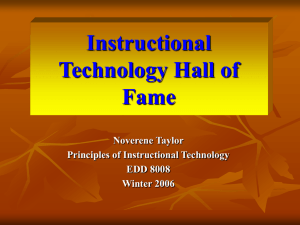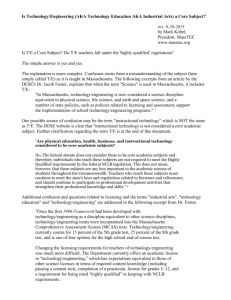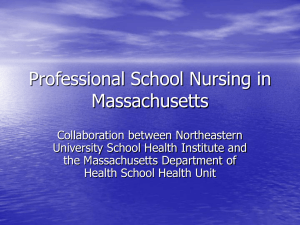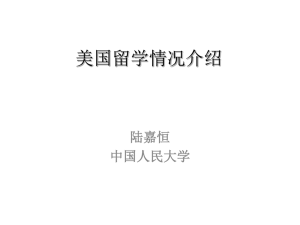Science and Technology Example DDMs: Core Course Objectives
advertisement
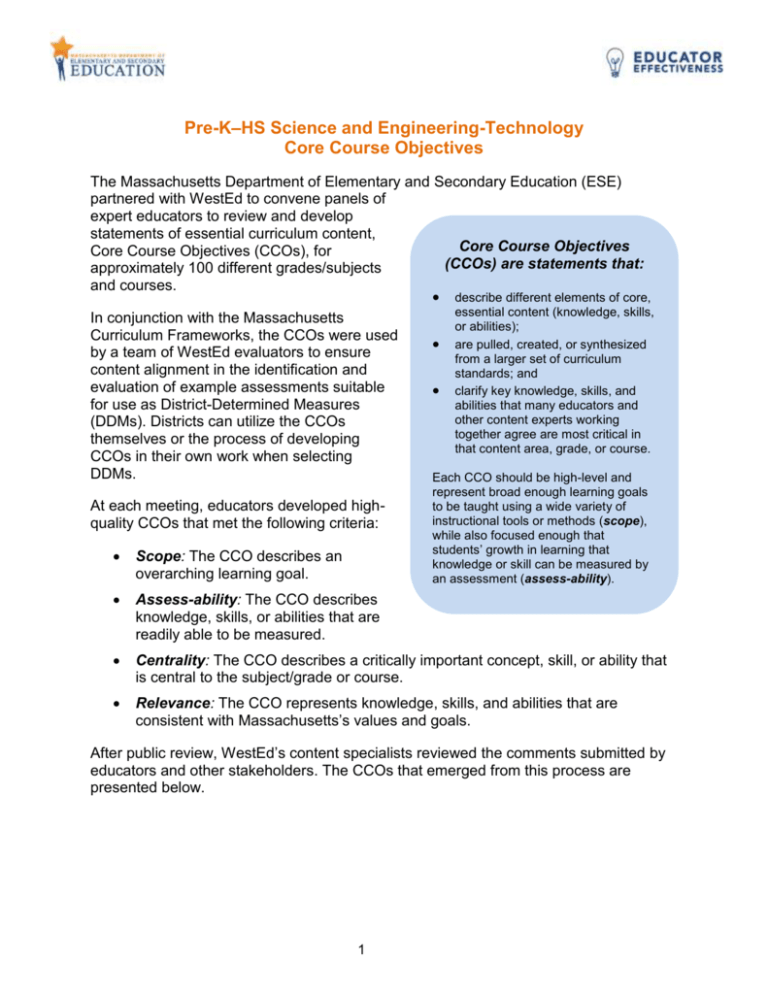
Pre-K–HS Science and Engineering-Technology Core Course Objectives The Massachusetts Department of Elementary and Secondary Education (ESE) partnered with WestEd to convene panels of expert educators to review and develop statements of essential curriculum content, Core Course Objectives Core Course Objectives (CCOs), for (CCOs) are statements that: approximately 100 different grades/subjects and courses. describe different elements of core, essential content (knowledge, skills, In conjunction with the Massachusetts or abilities); Curriculum Frameworks, the CCOs were used are pulled, created, or synthesized by a team of WestEd evaluators to ensure from a larger set of curriculum content alignment in the identification and standards; and evaluation of example assessments suitable clarify key knowledge, skills, and for use as District-Determined Measures abilities that many educators and other content experts working (DDMs). Districts can utilize the CCOs together agree are most critical in themselves or the process of developing that content area, grade, or course. CCOs in their own work when selecting DDMs. Each CCO should be high-level and At each meeting, educators developed highquality CCOs that met the following criteria: represent broad enough learning goals to be taught using a wide variety of instructional tools or methods (scope), while also focused enough that students’ growth in learning that knowledge or skill can be measured by an assessment (assess-ability). Scope: The CCO describes an overarching learning goal. Assess-ability: The CCO describes knowledge, skills, or abilities that are readily able to be measured. Centrality: The CCO describes a critically important concept, skill, or ability that is central to the subject/grade or course. Relevance: The CCO represents knowledge, skills, and abilities that are consistent with Massachusetts’s values and goals. After public review, WestEd’s content specialists reviewed the comments submitted by educators and other stakeholders. The CCOs that emerged from this process are presented below. 1 Massachusetts District-Determined Measures Core Course Objectives (CCOs) Science – Grade: Pre-K # Objective 1 Students use science inquiry skills to ask questions and communicate observations about the objects, organisms, and events in the environment. 2 Students differentiate between living and nonliving things and recognize the characteristics of living organisms (e.g., organisms such as animals and plants are living things that grow and reproduce). 3 Students recognize that water, rocks, soil, and living organisms are found on the earth’s surface. 4 Students sort objects by observable properties, such as size, shape, color, weight, and texture. 5 Students describe and model the various ways that objects can move, such as in a straight line, zigzag, back-and-forth, round-and-round, and slow. 6 Students identify tools and simple machines used for a specific purpose. 7 Students describe how human beings use parts of the body as tools (e.g., teeth for cutting, hands for grasping and catching) and compare their use with ways in which animals use parts of their bodies. Note: These Core Course Objectives were developed by Massachusetts educators in summer 2013. They are intended to provide districts with information about the content taught in this course. Source document used is as follows: Massachusetts Science and Technology/Engineering Curriculum Framework (2006). 2 Massachusetts District-Determined Measures Core Course Objectives (CCOs) Science – Grade: K # Objective 1 Through observation and simple experimentation, students recognize that the Sun supplies heat and light to the earth and is necessary for life. 2 Students recognize that people and other animals interact with the environment through their senses of sight, hearing, touch, smell, and taste. 3 Students sort objects by observable properties, such as size, shape, color, weight, and texture. Students identify objects and materials as solid or liquid. 4 Students identify and model the safe and proper use of tools and materials (e.g., glue, scissors, tape, ruler, paper, toothpicks, straws, spools) to construct simple structures. 5 Students use science inquiry skills to ask, “Why and what would happen if…” questions about the objects, organisms, and events in their environment. 6 Students identify some events around us that have repeating patterns, including seasons of the year and day and night. 7 Students plan and conduct an investigation to compare the effects of different strengths and different directions of pushes and pulls on the motion of an object (e.g., straight line, zigzag, back-and-forth, round-and-round, fast and slow). Note: These Core Course Objectives were developed by Massachusetts educators in summer 2013. They are intended to provide districts with information about the content taught in this course. Source documents used are as follows: Massachusetts Science and Technology/Engineering Curriculum Framework (2006); The Next Generation Science Standards (2013). 3 Massachusetts District-Determined Measures Core Course Objectives (CCOs) Science – Grade: 1 # Objective 1 Through observation, students identify some events around them that have repeating patterns, including the seasons of the year, and day and night, and describe changes in the weather from day to day and from season to season. 2 Students identify characteristics of natural materials (e.g., wood, cotton, fur, wool) and human-made materials (e.g., plastic, Styrofoam), and identify and explain some possible uses for each material. 3 Students use science inquiry skills to make predictions based on observable patterns. Students name and use simple tools, such as a ruler and a balance, when gathering data. 4 Students identify objects and materials as solid, liquid, or gas. 5 Students recognize that animals and plants are living things that grow; reproduce; need food, air, and water; and have life cycles, and that life cycles vary for different living things. Note: These Core Course Objectives were developed by Massachusetts educators in summer 2013. They are intended to provide districts with information about the content taught in this course. Source document used is as follows: Massachusetts Science and Technology/Engineering Curriculum Framework (2006); The Next Generation Science Standards (2013). 4 Massachusetts District-Determined Measures Core Course Objectives (CCOs) Science – Grade: 2 # Objective 1 Students identify the ways in which an organism’s habitat provides for its basic needs and can be influenced by seasonal changes (plants require air, water, nutrients, and light; animals require food, water, air, and shelter). 2 Students use tools to collect weather data and record changes over time. 3 Students identify objects and materials as solids (which have their own shape) or as liquids or gases (which take the shape of their container). 4 Students use the steps of the Engineering Design Process to construct simple structures. 5 Students will use science inquiry skills to ask questions, conduct investigations, and record their observations and/or data to share. Note: These Core Course Objectives were developed by Massachusetts educators in summer 2013. They are intended to provide districts with information about the content taught in this course. Source documents used are as follows: Massachusetts Science and Technology/Engineering Curriculum Framework (2006); The Next Generation Science Standards (2013). 5 Massachusetts District-Determined Measures Core Course Objectives (CCOs) Science – Grade: 3 # Objective 1 Students describe how water on earth cycles in different forms and in different locations, such as underground, in the atmosphere, and in different climactic regions. 2 Students identify materials and tools used to accomplish a design task based on specified criteria (e.g., weather related to hazards, properties of materials, bridge building, and solving environmental issues). 3 Students record and analyze data related to scientific investigations and experimentation. 4 Students sort and classify different objects and materials in order to differentiate between the properties of objects (size, shape, weight) and properties of materials (color, texture, hardness). 5 Students recognize that plants and animals go through predictable life cycles that are diverse but are inclusive of birth, development, reproduction, and death. 6 Students use evidence to construct an explanation of how inherited characteristics may change over time in the form of adaptations to changes in the environment for survival. 7 Students use science inquiry skills to ask questions and make predictions that can be tested while conducting simple investigations or experiments. Note: These Core Course Objectives were developed by Massachusetts educators in summer 2013. They are intended to provide districts with information about the content taught in this course. Source document used is as follows: Massachusetts Science and Technology/Engineering Curriculum Framework (2006); The Next Generation Science Standards (2013). 6 Massachusetts District-Determined Measures Core Course Objectives (CCOs) Science – Grade: 4 # Objective 1 Students identify the basic forms of energy and demonstrate understanding that energy is the ability to cause motion and create change, by modeling how energy can be transferred from one form to another. 2 Students identify internal and external structures of plants and animals that function to support survival, growth, behavior, and reproduction. 3 Students describe changes to the surface of the earth due to erosion and weathering. 4 Students differentiate between weather and climate. 5 Students define a simple design problem reflecting a need or a want that includes specified criteria for success and constraints on materials, time, and cost. Note: These Core Course Objectives were developed by Massachusetts educators in summer 2013. They are intended to provide districts with information about the content taught in this course. Source documents used are as follows: Massachusetts Science and Technology/Engineering Curriculum Framework (2006); The Next Generation Science Standards (2013). 7 Massachusetts District-Determined Measures Core Course Objectives (CCOs) Science – Grade: 5 # Objective 1 Students develop models for the earth’s rotation around its axis and its revolution around the sun that explains the reason for day and night and earth’s seasons. 2 Students explain how the sun’s energy creates global patterns, such as the jet stream and water currents, that influence local weather in measurable terms, such as temperature, wind direction and speed, and precipitation. 3 Students explain how energy derived from the sun provides the energy to sustain all life. 4 Students describe how organisms meet some of their needs in an environment by using behaviors (patterns of activities) in response to information (stimuli) received from the environment, and determine if the behavior is instinctive (e.g., turtles burying their eggs) or learned (e.g., humans building fires for warmth, chimpanzees learning how to use tools). 5 Students describe how energy has the ability to cause motion or create change by explaining how energy can be transferred from one form to another. 6 Students list examples of how organisms can cause changes in their environment to ensure survival, and explain how some of these changes may affect the ecosystem. 7 Students can explain how energy can be transformed from one form into another (i.e., plants capture energy from sunlight which can later be used as fuel or food, a radio converts electrical energy to sound, the chemical energy in food is converted by organisms for growth and development). 8 Students identify relevant design features (e.g., size, shape, weight) for building a prototype of a solution to a given problem. Note: These Core Course Objectives were developed by Massachusetts educators in summer 2013. They are intended to provide districts with information about the content taught in this course. Source documents used are as follows: Massachusetts Science and Technology/Engineering Curriculum Framework (2006); The Next Generation Science Standards (2013); National Research Council Framework for K–12 Science Education (2012). 8 Massachusetts District-Determined Measures Core Course Objectives (CCOs) Science – Grade: 6 # Objective 1 Students identify and explain the steps of the engineering design process; i.e., identify the need or problem, research the problem, develop possible solutions, select the best possible solution(s), construct a prototype, test and evaluate, communicate the solution(s), and redesign. 2 Students determine the measurement of volume and mass, which requires an understanding of the sensitivity of measurement tools. 3 Students explain how there are more than 100 elements that combine in a multitude of ways to produce compounds that make up all of the living and nonliving things that we encounter, and give examples of elements and compounds. 4 Students differentiate between an atom and a molecule. 5 Students differentiate between mixtures and pure substances. 6 Students explain that all organisms are composed of cells, and that many organisms are single-celled. 7 Students compare and contrast plant and animal cells, including major organelles (cell membrane, cell wall, nucleus, cytoplasm). 8 Students describe the layers of the earth, including the lithosphere, the hot convecting mantle, and the dense metallic core. 9 Students describe how the movement of the earth’s crustal plates causes both slow changes in the earth’s surface (e.g., formation of mountains and ocean basins) and rapid ones (e.g., volcanic eruptions and earthquakes). 10 Students describe and give examples of ways in which the earth’s surface is built up and torn down by natural processes, including deposition of sediments, rock formation, erosion, and weathering. 11 Students explain and give examples of how physical evidence, such as fossils and surface features of glaciation, supports theories that the earth has evolved over geologic time. Note: These Core Course Objectives were developed by Massachusetts educators in summer 2013. They are intended to provide districts with information about the content taught in this course. Source document used is as follows: Massachusetts Science and Technology/Engineering Curriculum Framework (2006). 9 Massachusetts District-Determined Measures Core Course Objectives (CCOs) Science – Grade: 7 # Objective 1 Students explain the relationship among the energy provided by the sun, the global patterns of atmospheric movement, and the temperature differences among water, land, and atmosphere. 2 Students differentiate among radiation, conduction, and convection, the three mechanisms by which heat is transferred through the earth's system. 3 Students explain how the tilt of the earth and its revolution around the sun result in an uneven heating of the earth, which in turn causes the seasons. 4 Students differentiate between volume and mass, and measure these properties to solve problems involving density. 5 Students give examples of how heat moves in predictable ways, moving from warmer objects to cooler ones until they reach equilibrium. 6 Students compare and contrast plant and animal cell organelles in terms of function. 7 Students recognize that within cells, many of the basic functions of organisms are carried out. The way in which cells function is similar in all living organisms. 8 Students recognize that producers use the energy from sunlight to make sugars from carbon dioxide and water through a process called photosynthesis. 9 Students describe the hierarchical organization of multicellular organisms from cells to tissues to organs to systems to organisms. 10 Students identify and explain the steps of the Engineering Design Process and demonstrate methods of representing solutions to a design problem, including the construction of a prototype. Note: These Core Course Objectives were developed by Massachusetts educators in summer 2013. They are intended to provide districts with information about the content taught in this course. Source documents used are as follows: Massachusetts Science and Technology/Engineering Curriculum Framework (2006); The Next Generation Science Standards (2013); Common Core State Standards. 10 Massachusetts District-Determined Measures Core Course Objectives (CCOs) Science – Grade: 8 # Objective 1 Students evaluate competing design solutions using a systematic process to determine how well each design solution meets the criteria and constraints of the problem. 2 Students analyze data from tests to determine similarities and differences among several design solutions to identify the best characteristics of each solution, and to create a new solution to better meet the criteria for success based on this analysis (redesign). 3 Students construct and present arguments using evidence to support the claim that weight is a result of gravitational interactions that are attractive and depend on the masses of interacting objects. 4 Students explain and give examples of how the motion of an object can be described by its position, direction of motion, and speed, using distance versus time graphs. 5 Students demonstrate why asexual reproduction results in offspring with identical genetic information and sexual reproduction results in offspring with genetic variation. 6 Students give examples of ways in which genetic variation and environmental factors are causes of evolution and the diversity of organisms. 7 Students describe lunar and solar eclipses, the observed moon phases, and tides, by relating them to the relative positions of the earth, moon, sun, and the force of gravity. 8 Students compare and contrast properties and conditions of objects in the solar system to those on earth. 9 Students demonstrate the principles of science when posing and answering a question, and demonstrate the principles of engineering by solving a problem using deliberate processes. Note: These Core Course Objectives were developed by Massachusetts educators in summer 2013. They are intended to provide districts with information about the content taught in this course. Source documents used are as follows: Massachusetts Science and Technology/Engineering Curriculum Framework (2006); The Next Generation Science Standards (2013); Common Core State Standards. 11 Massachusetts District-Determined Measures Core Course Objectives (CCOs) Science/Biology – Advanced Studies – Grade: HS # Objective 1 Students provide evidence that the process of evolution drives the diversity and unity of life. 2 Students evaluate how biological systems utilize free energy and molecular building blocks to grow, reproduce, and maintain dynamic homeostasis. 3 Students analyze how living systems store, retrieve, transmit, and respond to information essential to life processes. 4 Students demonstrate that biological systems interact and possess complex properties. 5 Students illustrate relationships among the major themes of biology: science as a process, evolution, energy transfer, continuity and change, relationship to structure and function, regulation, interdependence in nature, science, technology and society. 6 Students conduct scientific investigations, evaluate data, and draw valid conclusions. 7 Students design scientific inquiries that incorporate mathematical analysis. 8 Students justify conclusions based on data. 9 Students evaluate scientific findings, refute or defend conclusions, and communicate results. 10 Students apply biological knowledge and critical thinking skills to environmental and social concerns. Note: These Core Course Objectives were developed by Massachusetts educators in summer 2013. They are intended to provide districts with information about the content taught in this course. Source documents used are as follows: College Board, AP Biology, Course and Exam Description, Revised Edition (2012); Common Core State Standards; Massachusetts Science and Technology/Engineering Curriculum Framework (2006). 12 Massachusetts District-Determined Measures Core Course Objectives (CCOs) Science/Chemistry – Advanced Studies – Grade: HS # Objective 1 Structure Of Matter Students explain, using examples, that chemical elements are fundamental building blocks of matter, and all matter can be understood in terms of the arrangement of atoms. 2 Properties Of Matter Students identify the chemical and physical properties of matter based on the structure and arrangement of atoms, ions, or molecules, and the forces between them. 3 Chemical Reactions Students describe changes in matter that involve the rearrangement and/or reorganization of atoms and/or the transfer of electrons. 4 Rates Of Chemical Reactions Students identify factors that can change the rate of a chemical reaction. 5 Thermodynamics Students describe, explain, and predict the direction of changes in matter and the role of energy in those changes, using the laws of thermodynamics. 6 Equilibrium Processes Students describe how stresses applied to a system at equilibrium will affect the equilibrium position. 7 Applications Of Equilibrium Students apply equilibrium concepts to predict the behavior of solutions. 8 Experimental Design Students design and conduct scientific investigations to confirm the basic laws of chemistry and/or solve real world problems. 9 Data Analysis Students follow the conventions of scientific inquiry by constructing and using tables and graphs, solving mathematical expressions, making models and other representations, and/or making and recording precise and accurate measurements. Note: These Core Course Objectives were developed by Massachusetts educators in summer 2013. They are intended to provide districts with information about the content taught in this course. Source documents used are as follows: College Board, AP Chemistry, Course and Exam Description (2013); Massachusetts Science and Technology/Engineering Curriculum Framework (2006). 13 Massachusetts District-Determined Measures Core Course Objectives (CCOs) Science/Applied Biology – Chemistry – Grade: HS # Objective 1 Students design, conduct, and report conclusions of scientific experiments focused on practical applications of chemical and biological concepts. 2 Students apply knowledge of chemical substances and reactions to describe practical applications relating to foods, medicines, fuels, industrial products, and/or environmental solutions. 3 Students apply knowledge of molecular biology and cell biology to describe practical applications in the fields of medicine, food science, and human impact on natural systems. 4 Students illustrate the relationships and impacts among industrial, medical, and environmental systems that result from advances in chemistry and biology. 5 Students recognize that acids and bases are biologically and environmentally important, and relate the relevance of buffers to organisms and/or ecological systems. 6 Students relate the cycling of matter and flow of energy to processes within living and nonliving systems. 7 Students predict the change in equilibrium when a system is subjected to change (e.g., change in temperature, pressure, pH, concentration). 8 Students evaluate the hypotheses, data, analyses, and conclusions in a science or technical text, verifying data when possible, and corroborating or challenging conclusions with other sources of information. 9 Students synthesize information from a range of sources (e.g., texts, experiments, simulations) into a coherent understanding of a process, phenomenon, or concept, resolving conflicting information when possible. Note: These Core Course Objectives were developed by Massachusetts educators in summer 2013. They are intended to provide districts with information about the content taught in this course. Source documents used are as follows: Wallingford Public Schools, High School Applied Chemistry (Connecticut); Massachusetts Science and Technology/Engineering Curriculum Framework (2006). 14 Massachusetts District-Determined Measures Core Course Objectives (CCOs) Science/Physics – Advanced Studies – Grade: HS # Objective 1 Students apply Newton’s Laws of motion and gravitation to analyze, interpret, and calculate the forces and motions of objects. 2 Students analyze and apply the laws of conservation of energy and momentum to evaluate movement of real world objects. 3 Students demonstrate understanding of heat transfer when analyzing changes in materials. 4 Students explain and relate the concepts of wave motion to real world applications. 5 Students interpret and apply knowledge of electricity and magnetism based on experimental and theoretical data. 6 Students use mathematical analysis, scientific inquiry, and engineering design to pose questions, seek answers, and develop solutions. 7 Students create graphical representations of data to analyze trends and patterns, and extrapolate from the data to form predictions and/or new questions. 8 Students design experiments to defend a testable hypothesis. 9 Students defend hypotheses and experimental data with scientific textual and literature reviews, either supporting or refuting conclusions. Note: These Core Course Objectives were developed by Massachusetts educators in summer 2013. They are intended to provide districts with information about the content taught in this course. Source documents used are as follows: Massachusetts Science and Technology/Engineering Curriculum Framework (2006); College Board, AP Physics, Course Description (2012); New York Regents Physics Standards. 15 Massachusetts District-Determined Measures Core Course Objectives (CCOs) Science/Anatomy and Physiology – Grade: HS # Objective 1 Students apply the correct anatomical terminology when explaining body structures (e.g., bones, muscles, and organs) and regions. 2 Students recognize that the body’s systems interact to maintain homeostasis. 3 Students analyze the interdependent nature of the cardiovascular, digestive, and respiratory systems. 4 Students explain how the skeletal and muscular systems work together to support, protect, and move body structures. 5 Students demonstrate understanding of the mechanisms of digestion and absorption. 6 Students explain how the nervous system mediates the body’s interactions with the environment. 7 Students identify the major tissue types, differentiating the structure and function of each. 8 Students observe, measure, and manipulate specimens in the laboratory using tools and measures safely and appropriately. 9 Students conduct scientific inquiry, demonstrate computation and graphing skills necessary for data analysis, and clearly communicate results. 10 Students identify the major organs of the cardiovascular, respiratory, and digestive systems, and analyze how these systems work together. 11 Students explain the importance of the physiological processes that occur during exercise. Note: These Core Course Objectives were developed by Massachusetts educators in summer 2013. They are intended to provide districts with information about the content taught in this course. Source documents used are as follows: Massachusetts Science and Technology/Engineering Curriculum Framework (2006); Georgia Performance Standards (2006); Tennessee Science Standards (2007–2008). 16 Massachusetts District-Determined Measures Core Course Objectives (CCOs) Science/Astronomy – Grade: HS # Objective 1 Students describe the scientific view of the origin of the universe, the evolution of matter, and the development of celestial objects. 2 Students compare and contrast evidence supporting current views of the universe with historical views. 3 Students relate the relative positions of earth, the moon, and the sun to observable phenomena (visibility of other planets, lunar phases, eclipses, and seasons). 4 Students describe and explain the celestial sphere and astronomical observations made from the point of reference of earth. 5 Students explain the tools used by modern and historical astronomers to observe the universe. 6 Students explain the characteristics and life cycles of stars, and interpret the H-R diagram. 7 Students identify the properties of a variety of types of galaxies, including the Milky Way Galaxy. 8 Students describe the benefits and challenges of space exploration as they relate to the study of the universe. 9 Students cite specific textual evidence to support analysis of science and technical texts, attending to important distinctions the author makes and to any gaps or inconsistencies in the account. 10 Students write informative/explanatory texts, including the narration of historical events, scientific procedures/experiments, or technical processes. Note: These Core Course Objectives were developed by Massachusetts educators in summer 2013. They are intended to provide districts with information about the content taught in this course. Source documents used are as follows: Georgia Performance Science Standards (2009); South Carolina Science Academic Standards (2005); Texas Essential Knowledge & Skills for Science (2009); Massachusetts English Language Arts and Literacy Curriculum Framework (2011); The Next Generation Science Standards (2013). 17 Massachusetts District-Determined Measures Core Course Objectives (CCOs) Science/Earth and Space Science – Grade: HS # Objective 1 Students identify and classify celestial objects in the universe. 2 Students describe how our solar system formed in the Milky Way Galaxy about 4.6 billion years ago. 3 Students apply evidence supporting the Big Bang Theory as an explanation of the origin of the universe. 4 Students explain how energy from the sun contributes to global and/or local processes. 5 Students provide evidence to support the theory of plate tectonics. 6 Students translate quantitative or technical information expressed in text into a visual format (tables, charts, graphs, maps, etc.), and translate information expressed visually or mathematically (equations) into words. 7 Students describe the mechanisms that drive surface and deep water currents and the relationship of these currents to global and local climate. 8 Students compare and contrast findings presented in text to those from other sources (including their own experiments), noting when the findings support or contradict previous explanations or accounts. 9 Students compare the positive and negative environmental impacts of human activity on renewable and nonrenewable resources. 10 Students describe how water cycles through a watershed, providing drinking water. 11 Students explain and provide evidence of how earth’s surface has changed over different scales of time. 12 Students model the earth-moon-sun relationships that produce the seasons, solar eclipses, lunar eclipses, and tides. 13 Students identify earth’s internal and external energy sources, and describe how the energy is transferred through conduction, convection, and radiation. 14 Students interpret weather maps and make predictions about future weather. 18 Massachusetts District-Determined Measures Core Course Objectives (CCOs) # Objective 15 Students analyze geoscience data and results from global climate models to explain how human activity impacts climate over time, and extrapolate possible future changes in climate from the data. 16 Students describe how matter cycles through Earth system. Note: These Core Course Objectives were developed by Massachusetts educators in summer 2013. They are intended to provide districts with information about the content taught in this course. Source documents used are as follows: Massachusetts Science and Technology/Engineering Curriculum Framework (2006); The Next Generation Science Standards (2013); Massachusetts English Language Arts and Literacy Curriculum Framework (2011). 19 Massachusetts District-Determined Measures Core Course Objectives (CCOs) Science/Environmental Science – Grade: HS # Objective 1 Students model how ecosystems have carrying capacities that result from the availability of resources necessary to the organisms’ survival. 2 Students construct an explanation using evidence for how the availability and conservation of natural resources impacts ecosystems. 3 Students illustrate how matter (water, carbon, and/or nitrogen) cycle among abiotic and biotic components. 4 Students evaluate how pollution impacts the environment (air, water and/or soil quality) in terms of wildlife, vegetation, and human health. 5 Students formulate an argument on the benefits and harmful effects of human activity on biodiversity. 6 Students design, evaluate, and refine a sustainable energy solution for reducing the impacts of human activities on the environment. 7 Students analyze geoscience data (i.e., fossil, ice cores, and soil cores) to support the claim that climate change can alter or create feedback loops affecting other earth systems. 8 Students evaluate the environmental costs and benefits associated with consumption of different energy sources. 9 Students describe causes (i.e., technological, environmental, political, and economic) for current and historical trends in human population growth in different regions of the world. 10 Students evaluate the environmental impact of changes in the flow of energy into and out of Earth’s systems (i.e., ocean currents, solar output, and composition of atmosphere). 11 Students predict the effects of non-native species on the stability of ecosystems. Note: These Core Course Objectives were developed by Massachusetts educators in summer 2013. They are intended to provide districts with information about the content taught in this course. Source documents used are as follows: The Next Generation Science Standards (2013); Massachusetts Science and Technology/Engineering Curriculum Framework (2006); District of Columbia Public Schools Environmental Science Standards; Common Core State Standards; College Board, AP Environmental Science, Course Description (2013). 20 Massachusetts District-Determined Measures Core Course Objectives (CCOs) Science/Marine Science – Grade: HS # Objective 1 Students describe the ecological impacts of human activity on marine ecosystems. 2 Students evaluate why certain organisms live in a particular marine ecosystem. 3 Students describe how organisms have adapted to the challenges of the marine environment. 4 Students construct a model for the cycling of water through the world’s one ocean. 5 Students distinguish among the ocean zones and describe their characteristics. 6 Students describe the bio-geological processes and chemical composition of the ocean. 7 Students analyze the ocean’s influence on weather and climate. 8 Students explain the role of aquaculture and fisheries management as humans work to restore ecological balance with the world ocean. 9 Students describe the motions of the ocean and their broad impacts on coastal shorelines. Note: These Core Course Objectives were developed by Massachusetts educators in summer 2013. They are intended to provide districts with information about the content taught in this course. Source documents used are as follows: Ocean Literacy: the Essential Principles and Fundamental Concepts of Ocean Sciences for Learners of All Ages (Version 2, March 2013); National Marine Educators’ Association, Special Report on the Ocean Literacy Campaign featuring the Ocean Literacy Scope and Sequence (2010); Freehold Regional High School, District Office of Curriculum and Instruction, Science Department, Lab Marine Science (New Jersey, August 2010); Cambridge International A & AS Level Marine Science (for examination in June 2013). 21 Massachusetts District-Determined Measures Core Course Objectives (CCOs) Engineering-Technology – Engineering Technology – Grade: HS # Objective 1 Students describe the role of engineers in society. 2 Students demonstrate and apply engineering design process. 3 Students demonstrate diagnostic and problem-solving skills in troubleshooting existing systems. 4 Students demonstrate problem-solving, diagnostics, and troubleshooting skills in the development of systems, prototypes, and products. 5 Students define and describe types of engineering fields and skills. 6 Students document and effectively communicate how they have used the engineering design process. 7 Students identify and properly use the appropriate tools for a process (e.g., manufacturing processes, construction processes, communication processes). 8 Students design and build an electrical circuit that will behave according to design criteria. 9 Students build a scale model of a structure. 10 Students design, build, and test a structure that can withstand calculated forces. 11 Students communicate a message that is encoded, transmitted, and decoded over time and distance. 12 Students draw by hand an object using the techniques of orthographic, isometric, and other multi-view drawing. 13 Students select and defend choice of materials for a design solution based upon the materials’ properties. 14 Design and build a prototype that represents the solution to a problem and takes into account design criteria and constraints. 15 Students build a fluid-powered device that can operate within a set of constraints and criteria. 22 Massachusetts District-Determined Measures Core Course Objectives (CCOs) # Objective 16 Students design and build a system that is powered by an alternative or renewable energy source (e.g., wind, solar, geothermal, biomass, etc.). Note: These Core Course Objectives were developed by Massachusetts educators in summer 2013. They are intended to provide districts with information about the content taught in this course. Source documents used are as follows: Massachusetts Vocational Technical Education Framework, Manufacturing, Engineering & Technology Services Occupational Cluster, Engineering Technology (2012); NOCTI Assessment and Pre-Engineering/Engineering Technology Blueprint; Massachusetts Science and Technology/Engineering Curriculum Framework (2006). 23 Massachusetts District-Determined Measures Core Course Objectives (CCOs) Engineering-Technology – Technological Literacy – Grade: HS # Objective 1 Students explain and demonstrate the nature and operation of technology systems and their relationships to other fields of study. For example: Students can describe the core concepts of technology. Students recognize the ways in which technology co-evolves with science, mathematics, and other fields. Students demonstrate applications of technology in other areas and fields of study. 2 Students demonstrate the responsible use of technology with an understanding of ethics, morality, and safety issues at home, in school, and in society. For example: Explain fair use guidelines for using copyrighted materials. 3 Students describe the fundamental reasons for intellectual property laws. For example: Discuss misuse of technology for personal and commercial reasons (i.e., software piracy, unauthorized file sharing). 4 Students demonstrate how specialized technology tools can be used for problem-solving, decision-making, and creativity. For example: Students use simulation software, environmental probes, computer-aided design, geographic information systems, dynamic geometric software, graphing calculators, and art and music composition software. Students explore the use of a variety of technology tools across disciplines. Students identify problems in other disciplines that could be solved with the use of specific technology. 5 Students demonstrate the ability to select, evaluate, and use the proper information and communication technologies for a specific purpose. For example: Students use computers and calculators to access, retrieve, organize, process, maintain, interpret, and evaluate data and information in order to communicate. Students collaborate effectively with others, synthesize information from different sources, and communicate with multiple audiences. 6 Students demonstrate proficiency in the use of computers and applications. For example: Demonstrate effective backup and retrieval strategies. 24 Massachusetts District-Determined Measures Core Course Objectives (CCOs) # Objective 7 Students describe the concepts underlying hardware, software, network architecture, and connectivity. For example: Describe good practices for password protection and authentication. 8 Students use a variety of applications to plan, create, and edit multimedia presentations (e.g., slide presentations, videos, animations, simulations, podcasts, and other emerging technologies). For example: Identify technology tools (such as authoring tools) that can be used to create a multimedia presentation. 9 Students use acceptable practices for citing sources when incorporating ideas, quotations, and images into their own work. For example: Write in-text citations and reference lists for text and images gathered from electronic sources. 10 Students organize, analyze, and interpret data using technology tools (e.g., spreadsheets, databases, and graphing calculators). For example: Use functions of a spreadsheet application (i.e., sort, filter) in fulfilling an assigned task. 11 Students evaluate the effectiveness of website design based upon usability, visual form and function, and accessibility features. For example: Students navigate websites and use specific criteria to evaluate websites. Students write a critical review of a website. Students self-assess their own products as they design websites. 12 Students use HTML or web-authoring tools to create, edit, and publish well-organized websites with effective navigation. For example: Students collaborate to develop the content of web page. Students plan the layout and design of a website. Students self-assess their work as they design websites. 25 Massachusetts District-Determined Measures Core Course Objectives (CCOs) Note: These Core Course Objectives were developed by Massachusetts educators in summer 2013. They are intended to provide districts with information about the content taught in this course. Source documents used are as follows: Massachusetts Technology Literacy Standards and Expectations (2008); National Assessment of Educational Progress (NAEP), Technology and Engineering Literacy Framework (2014); Common Core State Standards; SDCS Educational Technology, Instruction, and Curriculum (2006); International Technology Education Association (ITEA), Standards for Technological Literacy: Content for the Study of Technology, Third Edition (2007). 26
